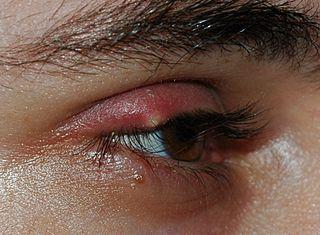Stye
Augenlid-Infektion
Begutachtet von Dr. Colin Tidy, MRCGPZuletzt aktualisiert von Dr. Hayley Willacy, FRCGP Zuletzt aktualisiert am 15. Januar 2025
Erfüllt die Anforderungen des Patienten redaktionelle Richtlinien
- HerunterladenHerunterladen
- Teilen Sie
- Sprache
- Diskussion
In dieser Serie:Geschwollenes AugenlidChalazionBlepharitisEktropiumLokale Anästhesie für Ihre Augenoperation
A stye is a small painful red lump on the edge of the eyelid. Most styes get better on their own and do not need medical treatment. Hot compresses can ease the pain and encourage the stye to burst.
In diesem Artikel:
Wichtigste Punkte
A stye is a small red bump on the edge of the eyelid that is caused by a bacterial infection. It usually only affects one eye.
Most styes go away on their own within a few days. Applying warm compresses 3-4 times a day can help ease pain and bring the stye to a head.
Don’t try to pop a stye, instead, let it drain naturally. If it doesn't go away after a few days, see a doctor who can offer advice and treatment options.
Lesen Sie unten weiter
Was ist ein Stye?
Styes sind eine Art bakterielle Infektion des Augenlids, die typischerweise zu einer schmerzhaften roten Beule entweder innerhalb oder außerhalb des Lids führt.
Sie sind ein sehr häufiges Augenproblem und entwickeln sich in der Regel recht schnell, innerhalb weniger Tage. In der Regel ist nur ein Auge betroffen, obwohl sich auch mehrere Stiche gleichzeitig entwickeln können, sogar auf demselben Augenlid.
Was ist ein Stye?
Arten von Stichen
Es gibt zwei Arten von Augenstichen: äußere Augenstiche (der häufigste Typ) und innere Augenstiche (die eher selten sind).
Äußeres Stye (äußeres Hordeolum)
Dies ist die häufigste Form eines Stains. Technisch gesehen handelt es sich um ein externes Stye, das jedoch oft nur als Stye bezeichnet wird. Er entsteht am Rand des Augenlids aufgrund einer Infektion des Wimpernfollikels (an der Stelle, an der eine Wimper am Augenlid befestigt ist).
Es kann als kleiner roter Klumpen beginnen, aber wenn er sich zu einer Eiteransammlung (einem kleinen Abszess) entwickelt, sieht er wie ein gelber, mit Eiter gefüllter Fleck aus. Der Rand des Augenlids ist gerötet und geschwollen, und das Lid schmerzt.
Externes Stäbchen

Von Andre Riemann, gemeinfrei, über Wikimedia Commons
Internes Stye (internes Hordeolum)
Ein inneres Stye entsteht, wenn die Öldrüsen im Hauptteil des Augenlids (Meibom-Drüse) mit Öl verstopft sind und sich dann entzünden. Die Infektion bildet sich an der Innenseite des Augenlids, am Augapfel, so dass sie von außen nur als Schwellung sichtbar ist.
Interne Styes können schmerzhaft sein, obwohl sie oft einen dumpfen Schmerz im Augenlid verursachen, manchmal mit dem Gefühl eines Klumpens. Interne Styes sind viel seltener als externe Styes.
Internes Stigma

Von Michal Klajban, CC BY-SA 3.0über Wikimedia Commons
Lesen Sie unten weiter
Stye Symptome
Zu den Anzeichen und Symptomen eines Stains gehören:
Eine rote Beule am Rande des Augenlids.
Die Beule kann sich mit gelbem Eiter füllen, der auslaufen kann.
Schmerzen im betroffenen Augenlid.
Anschwellen der Augenlider.
Tränendes Auge.
Was verursacht ein Stye?
Auge mit Oberlidstich

Oft wird die Frage gestellt: "Wodurch entstehen Augenstiche bei Erwachsenen? Die meisten Styes treten ohne offensichtlichen Grund auf. Wenn die Augenlider jedoch stark jucken oder gerieben werden, kann dies die Wahrscheinlichkeit eines externen Styes erhöhen.
Der übliche Keim (Bakterium), der die Infektion verursacht, heißt Staphylococcus aureus. Es handelt sich um einen weit verbreiteten Keim, der häufig auf gesunder Haut zu finden ist. Er richtet normalerweise keinen Schaden an. Gelegentlich kann er jedoch in die Haut eindringen und dort Infektionen wie Pickel, Abszesse und Stiche verursachen.
Risikofaktoren
Manche Menschen leiden an einer Augenliderkrankung namens Blepharitis. Dabei handelt es sich um eine Entzündung der Augenlider, bei der sie geschwollen, trocken und juckend werden können. Blepharitis kann die Anfälligkeit für die Entwicklung von Styes erhöhen.
Wenn Sie unter Akne, Rosazea oder seborrhoischer Dermatitis leiden, sind Sie möglicherweise anfälliger für die Entwicklung von Styes.
Auch ein schlecht eingestellter Diabetes erhöht das Risiko von Infektionen.
Lesen Sie unten weiter
Stye-Behandlung
Die meisten Menschen wollen wissen, wie sie ein Stye loswerden können.
Styes brauchen oft keine Behandlung. Der "Kopf" oder "Punkt" platzt in der Regel innerhalb von 3-4 Tagen auf.
Warme Kompressen können helfen, den Schmerz zu lindern und den Eiter zu verdrängen.
Sie sollten das Tragen von Kontaktlinsen und Augen-Make-up vermeiden, bis die Krankheit abgeklungen ist.
Die Einnahme von Antibiotika (Salben oder Medikamente) wird nicht empfohlen.
Es ist ratsam, Wimperntusche und Eyeliner, die Sie bei der Entstehung des Stains am Lidrand verwendet haben, zu entfernen. Auf diese Weise wird eine erneute Infektion des Auges vermieden. Optionen zur Beschleunigung der Auflösung des Styropors sind:
Keine Behandlung
Oft ist keine Behandlung notwendig, um ein Stye loszuwerden. Sobald sich ein "Kopf" oder eine "Spitze" auf einem Stye gebildet hat, platzen die meisten innerhalb von 3 bis 4 Tagen auf, wobei die winzige Menge an Eiter abfließt und keine weiteren Probleme hinterlässt. Es ist nicht ratsam, das Stye im Auge (wie einen Pickel) auszudrücken.
Heiße Kompressen
Diese können dazu beitragen, den Schmerz zu lindern und den Eiter zum Abfließen zu bringen. Das können Sie selbst tun: Halten Sie einen sauberen Waschlappen, den Sie in warmes Wasser getaucht und trockengedrückt haben, sanft, aber fest gegen das geschlossene Auge. Tun Sie dies 5-10 Minuten lang, 3-4 Mal am Tag. (Das Wasser sollte heiß sein; es sollte angenehm und nicht verbrühend sein.)
Irgendwann wird das Stye "aufplatzen" und abfließen - aber lassen Sie sich nicht dazu verleiten, es selbst aufzupressen. Sie könnten die Situation verschlimmern, indem Sie das empfindliche Augenlid verletzen oder die Infektion tiefer in das Gewebe eindringen lassen.
Epilation der Wimpern
Dies ist eine Behandlung für ein äußeres Stäbchen. Das bedeutet, dass die Wimper ausgezupft wird. Die Epilation ist kurzzeitig unangenehm, aber sie kann dazu beitragen, dass die Infektion aus dem Haarfollikel abfließt.
Inzision und Drainage eines externen Styros
Dieses Verfahren kann von einem Arzt durchgeführt werden und ist eine Behandlung für ein äußeres Stye. Es ist wie das Aufstechen eines Furunkels. Mit einer sterilen Nadel (oder vielleicht einem kleinen Skalpell) kann das Stye geöffnet und der Eiter abgelassen werden.
Sie sollten dies nicht selbst versuchen, da Sie die Infektion auf das Augenlid übertragen könnten, was schwerwiegende Folgen hätte.
Drainage eines inneren Stomas
Bei diesem Verfahren wird Ihr Augenlid mit einer Injektion eines Lokalanästhetikums betäubt und von innen nach außen geklappt, um das Stye freizulegen, bevor es ausgeschabt werden kann.
Sehr selten wird dieser Eingriff unter Vollnarkose durchgeführt, da er unangenehm ist und vor allem Kinder ihn als schwierig empfinden. Nach diesem Eingriff werden in der Regel antibiotische Augentropfen verabreicht.
Wie lange dauert ein Stye?
Ein Stye bricht normalerweise nach 3-4 Tagen von selbst auf, kann aber auch bis zu 1-2 Wochen andauern.
Gibt es irgendwelche Komplikationen?
Die meisten Styes sind sehr geringfügige Infektionen, die ohne Behandlung abklingen und keine Probleme verursachen. Styes beeinträchtigen die Sehkraft nicht.
Vorbeugung von Stichen
Augenringe werden durch ein Bakterium (Staphylococcus) verursacht, das in die verstopften Öldrüsen des Augenlids eindringt. Wenn Sie also auf eine gute Augenhygiene achten, können Sie das Auftreten von Augenringen verhindern.
Entfernen Sie das Augen-Make-up vor dem Schlafengehen.
Ersetzen Sie das Augen-Make-up regelmäßig, um Bakterienwachstum zu vermeiden.
Waschen Sie sich die Hände, bevor Sie die Augen oder Kontaktlinsen berühren.
Vermeiden Sie die gemeinsame Nutzung von Make-up, Handtüchern, Kissen oder anderen persönlichen Gegenständen.
Kann sich ein Stye in ein Chalazion verwandeln?
Manchmal geht das Stye nicht weg und kann sich in eine Zyste, ein Chalazion, verwandeln. Wenn das passiert, sieht es nicht besonders rot aus und tut nicht weh. Allerdings haben Sie dann einen Klumpen auf Ihrem Augenlid.
Kann aus einem Stye eine Bindehautentzündung werden?
In sehr seltenen Fällen kann sich die Infektion ausbreiten. Sie kann sich auf die Oberfläche des Auges ausbreiten und eine Bindehautentzündung hervorrufen, die möglicherweise eine antibiotische Salbe oder Tropfen erfordert, um die Infektion zu beseitigen.
Alternativ kann sich die Infektion auch um das Augenlid herum ausbreiten, so dass es stärker gerötet und geschwollen wird. In diesem Fall sollten Sie Ihren Hausarzt aufsuchen, da Sie möglicherweise Antibiotikatabletten benötigen.
Kann aus einem Stye eine Orbitalzellulitis werden?
Eine äußerst seltene Komplikation eines Augensteins tritt auf, wenn sich die Infektion auf das gesamte Augenlid und das Gewebe um und hinter dem Auge ausbreitet. Dies wird als orbitale Zellulitis bezeichnet.
Das Augenlid kann stark geschwollen und gerötet sein, es kann schmerzen oder unmöglich sein, das Auge zu öffnen, und Sie können starke Schmerzen und eine hohe Temperatur (Fieber) haben. Manchmal wird der Augapfel nach vorne gedrückt, so dass er sich vorwölbt, und Sie können sehr lichtempfindlich sein.
Wenn diese Art von Komplikation bei Ihnen auftritt, müssen Sie dringend einen Arzt aufsuchen. Die Behandlung der orbitalen Zellulitis erfolgt mit Antibiotika, die in der Regel im Krankenhaus über einen Tropf in eine Vene (intravenös) verabreicht werden.
Häufig gestellte Fragen
Warum bekomme ich immer wieder Augenringe?
Recurrent styes often result from conditions such as blepharitis, acne, or diabetes, or from poor eye hygiene. To prevent them, manage underlying conditions and maintain good eye hygiene by removing makeup daily, replacing old products, washing hands before touching eyes or lenses, and avoiding sharing makeup, towels, or pillows.
Sind Styes ansteckend?
Styes are not contagious. However, to reduce the chance of the infection spreading you should always wash your hands after touching the affected eyelid and do not wear contact lenses or eye make-up until the infection has settled.
Is a stye caused by stress?
Stress itself doesn’t directly cause a stye, but it can weaken your immune system, making you more prone to infections like styes. When you’re run down or under pressure, bacteria are more likely to infect an eyelash follicle or oil gland.
Should you pop a stye?
No, you should never pop a stye. Squeezing it can spread the infection or make it worse. Instead, apply a warm compress several times a day to help it drain naturally.
Dr. Mary Lowth ist eine der Autorinnen oder die ursprüngliche Autorin dieses Merkblatts.
Patienten wählen aus für Augenlid-Probleme

Gesundheit der Augen
Ektropium
Ektropium ist ein Zustand, bei dem sich ein Teil oder das gesamte untere Augenlid vom Auge weg nach außen dreht. Es gibt verschiedene Ursachen, aber die häufigste Ursache ist ein Alterungseffekt des Augenlids, der bei einigen älteren Menschen auftritt. Mit einer einfachen Operation kann das Problem in der Regel behoben werden.
von Dr. Colin Tidy, MRCGP

Gesundheit der Augen
Blepharospasmus
Blepharospasmus ist ein Zustand, bei dem das Blinzeln oder das krampfartige Schließen der Augen in erhöhter Frequenz auftritt. Er reicht von einem leichten, peinlichen Zucken oder Flattern eines Augenlids bis hin zu schweren Krämpfen beim Schließen der Augen, die das Sehen unterbrechen. Der sekundäre Blepharospasmus ist eine häufige Reaktion auf viele häufige Augenerkrankungen und kann durch einige Erkrankungen des Nervensystems verursacht werden. In diesem Merkblatt geht es hauptsächlich um den primären Blepharospasmus, auch gutartiger essenzieller Blepharospasmus (BEB) genannt. BEB kann nicht geheilt werden, wird aber in der Regel erfolgreich mit Botulinumtoxin-Injektionen behandelt, die in regelmäßigen Abständen wiederholt werden. Im Vereinigten Königreich müssen Sie, wenn Sie an Blepharospasmus leiden, dies der Driver and Vehicle Licensing Agency (DVLA) melden.
von Dr. Hayley Willacy, FRCGP
Weiterführende Literatur und Referenzen
- Stiche (Hordeola)NICE CKS, Oktober 2024 (nur UK Zugang)
- Willmann D, Guier CP, Patel BC, et alStye
- Lindsley K, Nichols JJ, Dickersin KNicht-chirurgische Interventionen für akutes internes Hordeolum. Cochrane Database Syst Rev. 2017 Jan 9;1:CD007742. doi: 10.1002/14651858.CD007742.pub4.
Lesen Sie unten weiter
Artikel Geschichte
Die Informationen auf dieser Seite wurden von qualifizierten Klinikern verfasst und von Fachleuten geprüft.
Nächste Überprüfung fällig: 14. Januar 2028
15 Jan 2025 | Neueste Version

Fragen, teilen, verbinden.
Stöbern Sie in Diskussionen, stellen Sie Fragen, und tauschen Sie Erfahrungen zu Hunderten von Gesundheitsthemen aus.

Fühlen Sie sich unwohl?
Beurteilen Sie Ihre Symptome online und kostenlos
Sign up to the Patient newsletter
Your weekly dose of clear, trustworthy health advice - written to help you feel informed, confident and in control.
By subscribing you accept our Privacy Policy. You can unsubscribe at any time. We never sell your data.